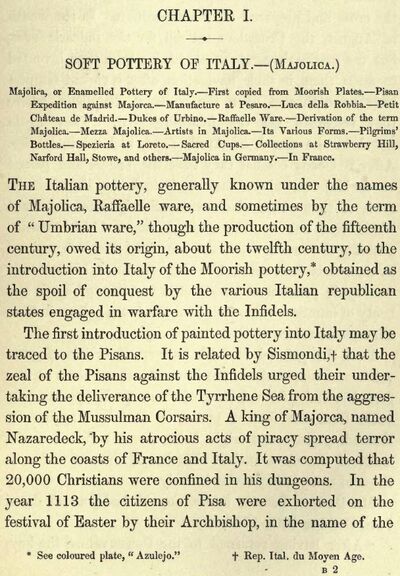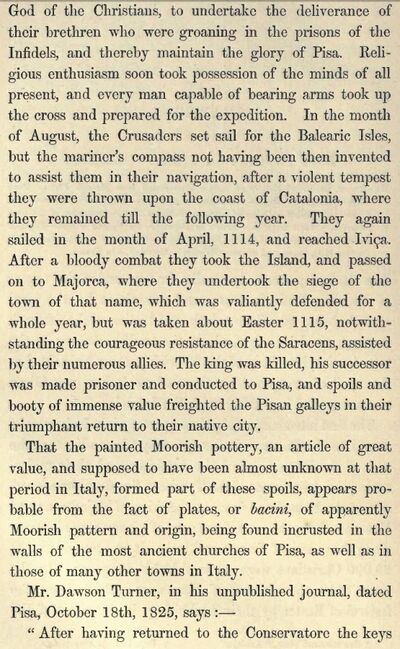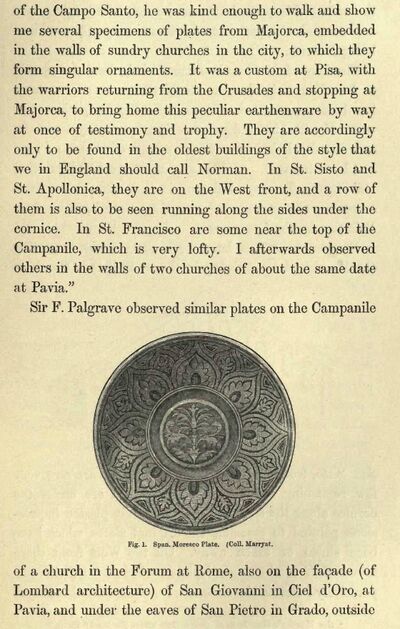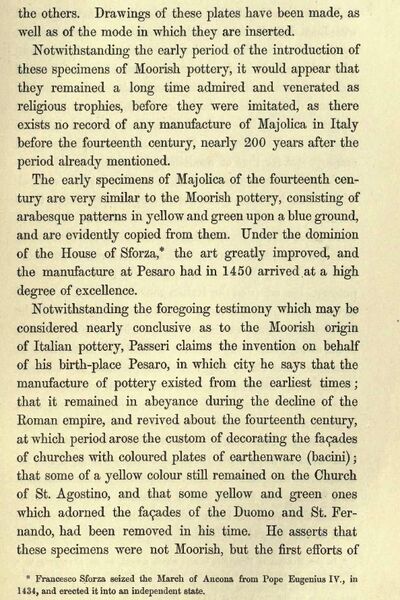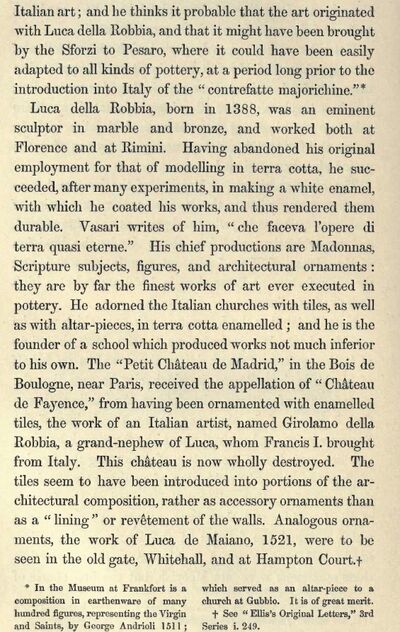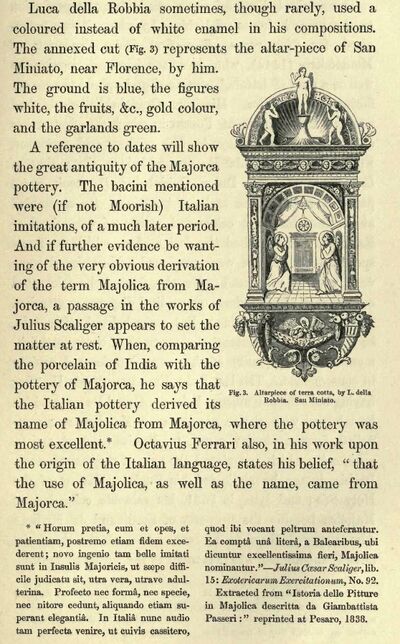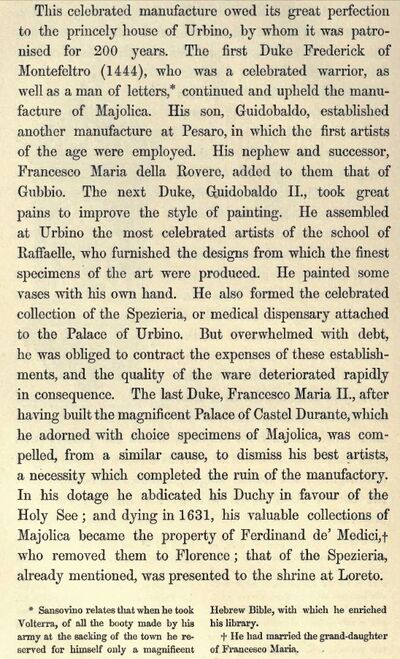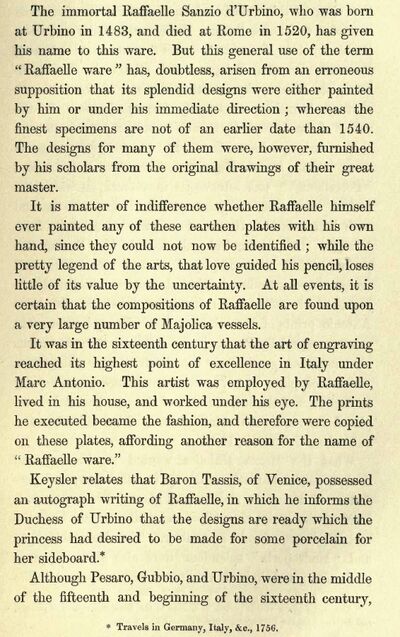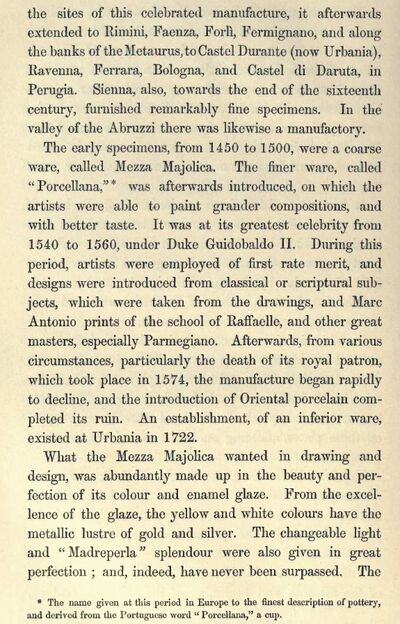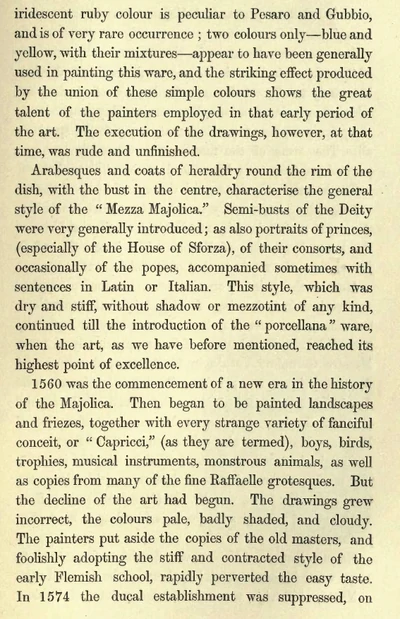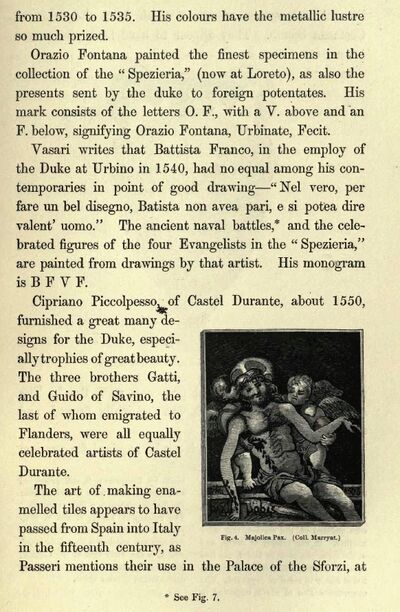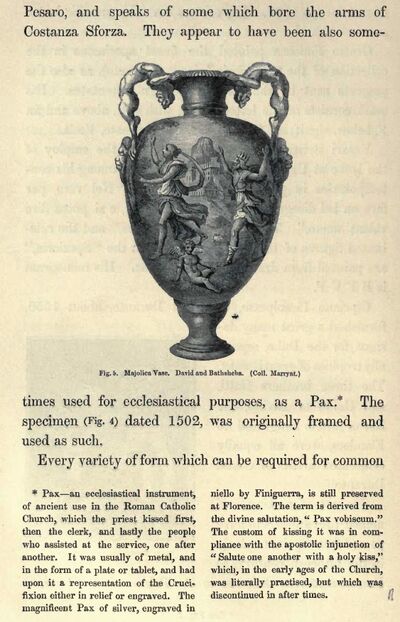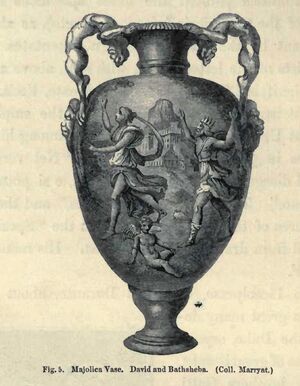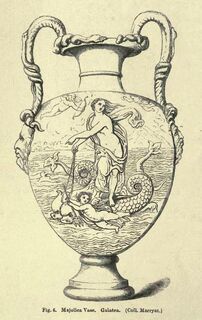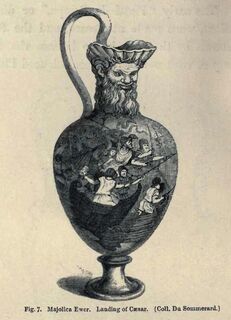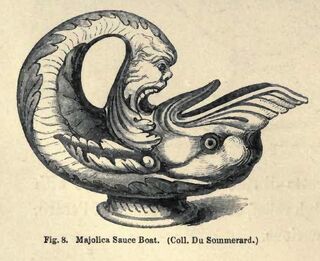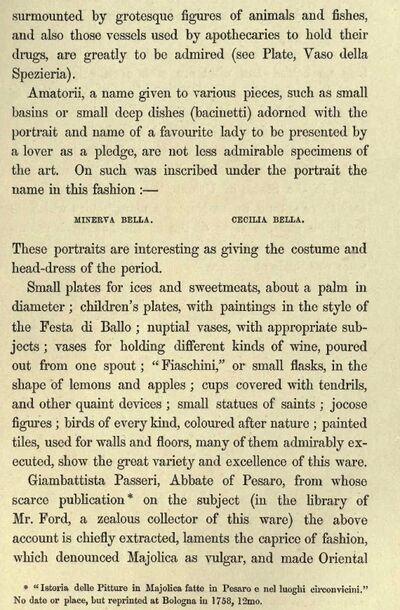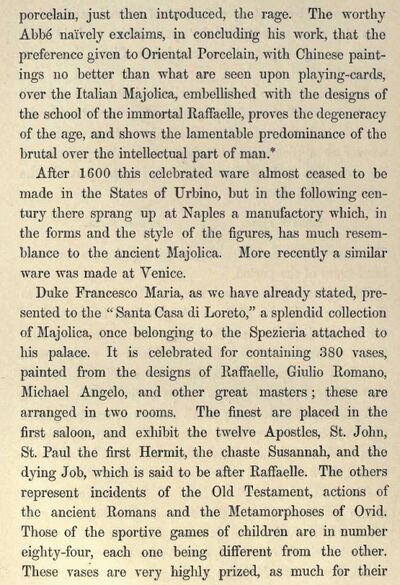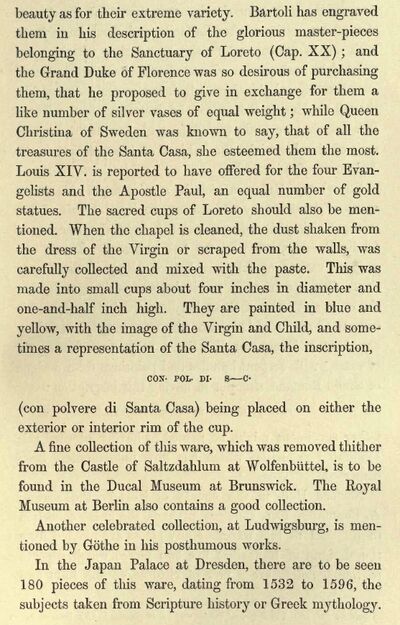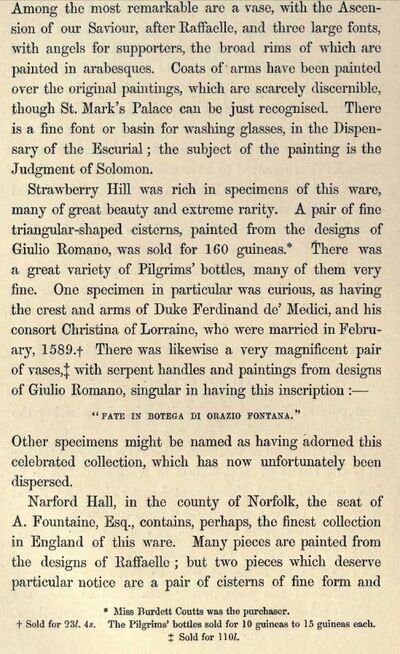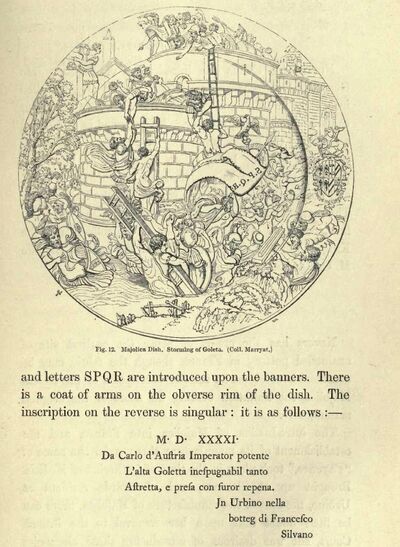3[]
The Italian pottery, generally known under the names of Majolica, RafFaelle ware, and sometimes by the term of " Umbrian
ware," though the production of the fifteenth century, owed its origin, about the twelfth century, to the introduction into
Italy of the Moorish pottery,[1] obtained as the spoil of conquest by the various
Italian republican states engaged in warfare with the Infidels.
The first introduction of painted pottery into Italy may be traced to the Pisans. It is related by Sismondi,[2] that the zeal of the Pisans against the Infidels urged their undertaking the deliverance of the Tyrrhene Sea from the aggression of the Mussulman Corsairs. A king of Majorca, named Nazaredeck, 'by his atrocious acts of piracy spread terror along the coasts of France and Italy. It was computed that 20,000 Christians were confined in his dungeons. In the year 1113 the citizens of Pisa were exhorted on the
festival of Easter by their Archbishop, in the name of the
La cerámica italiana, generalmente conocido con el nombre de mayólica, cerámica Raffaelle, ya veces por el término de "cerámica de Umbría", aunque la producción del siglo XV, debió su origen, hacia el siglo XII, a la introducción en Italia de la la cerámica musulmana, [1] obtenida como el botín de conquista por los diferentes Estados republicanos italiana que ejerce una guerra con los infieles.
La primera introducción de la cerámica pintada en Italia sólo pueden ser remonta a los pisanos. Se relaciona por Sismondi, [2] que el celo de los pisanos contra los infieles instó a su compromiso de la liberación del Tirreno de la agresión de los corsarios musulmanes. Un rey de Mallorca, llamado Nazaredeck, "por sus actos atroces de terror diseminado la piratería en las costas de Francia e Italia. Se calcula que 20.000 cristianos fueron confinados en sus mazmorras. En el año 1113 los ciudadanos de Pisa se exhortó en el festival de la Pascua por su arzobispo, en nombre de la
4[]
God of the Christians, to undertake the deliverance of their brethren who were groaning in the prisons of the Infidels, and thereby maintain the glory of Pisa. Religious enthusiasm soon took possession of the minds of all present, and every man capable of bearing arms took up the cross and prepared for the expedition. In the month of August, the Crusaders set sail for the Balearic Isles, but the mariner's compass not having been then invented to assist them in their navigation, after a violent tempest they were thrown upon the coast of Catalonia, where they remained till the following year. They again sailed in the month of April, 1114, and reached Ivicpa. After a bloody combat they took the Island, and passed on to Majorca, where they undertook the siege of the town of that name, which was valiantly defended for a whole year, but was taken about Easter 1115, notwithstanding the courageous resistance of the Saracens, assisted by their numerous allies. The king was killed, his successor was made prisoner and conducted to Pisa, and spoils and booty of immense value freighted the Pisan galleys in their triumphant return to their native city.
That the painted Moorish pottery, an article of great value, and supposed to have been almost unknown at that period in Italy, formed part of these spoils, appears probable from the fact of plates, or bacini, of apparently Moorish pattern and origin, being found incrusted in the walls of the most ancient churches of Pisa, as well as in those of many other towns in Italy.
Mr. Dawson Turner, in his unpublished journal, dated Pisa, October 18th, 1825, says : " After having returned to the Conservatore the keys
Dios de los cristianos, para llevar a cabo la deHverance de sus hermanos que gemían en las cárceles de los infieles, y mantener así la gloria de Pisa. El entusiasmo religioso pronto se apoderó de las mentes de todos los presentes, y cada hombre capaz de portar armas tomó la cruz y se preparó para la expedición. En el mes de agosto, los cruzados se embarcó para las Islas Baleares, pero la brújula no haber sido entonces inventó para ayudarles en su navegación, después de una violenta tormenta que fueron lanzados en la costa de Cataluña, donde permanecieron hasta el siguiente año. Otra vez salió en el mes de abril, 1114, y alcanzó Ivicpa. Después de un sangriento combate que tuvo la Isla, y se transmite a Mallorca, donde emprendieron el asedio de la ciudad del mismo nombre, que fue defendido valientemente por un año entero, sino que fue tomada sobre la Pascua 1115, a pesar de la valerosa resistencia de los sarracenos , ayudados por sus aliados numerosas. El rey fue asesinado, su sucesor fue hecho prisionero y conducido a Pisa, y el botín y el botín de inmenso valor cargado las galeras de Pisa en su regreso triunfal a su ciudad natal.
Que la cerámica pintada de la mora, un artículo de gran valor, y se supone que han sido casi desconocido en aquella época en Italia, formó parte de estos despojos, parece probable por el hecho de placas o Bacini, de modelo aparentemente árabes y de origen, siendo encuentran incrustadas en las paredes de las iglesias más antiguas de Pisa, así como en las de muchos otros pueblos de Italia.
5[]
of the Campo Santo, he was kind enough to walk and show me several specimens of plates from Majorca, embedded in the walls of sundry churches in the city, to which they form singular ornaments. It was a custom at Pisa, with the warriors returning from the Crusades and stopping at Majorca, to bring home this pecuhar earthenware by way at once of testimony and trophy. They are accordingly only to be found in the oldest buildings of the style that we in England should call Norman. In St. Sisto and St. Apollonica, they are on the West front, and a row of them is also to be seen running along the sides under the cornice. In St. Francisco are some near the top of the Campanile, which is very lofty. I afterwards observed others in the walls of two churches of about the same date at Pavia.
Sir F. Palgrave observed similar plates on the Campanile
Fig. 1. Span. Moresco Plate. (Coll. Manyat.
of a church in the Forum at Rome, also on the facade (of Lombard architecture) of San Giovanni in Ciel d'Oro, at Pavia, and under the eaves of San Pietro in Grade, outside
del Campo Santo, tuvo la amabilidad de caminar y me muestran varios ejemplares de las placas de Mallorca, incrustados en las paredes de las iglesias sin excepción en la ciudad, a la que forman adornos singulares. Era una costumbre en Pisa, con los guerreros que regresaban de las Cruzadas y con parada en Mallorca, para llevar a casa este barro pecuhar a través del testimonio a la vez y trofeo. Tienen, por consiguiente sólo se encuentran en los edificios más antiguos del estilo que en Inglaterra debe llamar a Norman. En San Sisto y San Apollonica, están en el frente occidental, y una fila de ellos es también por ver a lo largo de los costados debajo de la cornisa. En San Francisco son algunos cerca de la cima del Campanile, que es muy elevada. Yo después observó a otros en las paredes de dos iglesias que tienen aproximadamente la misma fecha en Pavía.
Sir F. Palgrave observaron placas similares en el Campanile
La figura. 1. Span. Moresco de la Plata. (Col. Manyat.
de una iglesia en el Foro en Roma, también en la fachada (de la arquitectura lombarda) de San Giovanni in Ciel d'Oro, en Pavía, y bajo el alero de San Pietro en el grado, en las afueras
6[]
the walls of Pisa ; the latter were chiefly of a bright green, and covered with patterns which had every appearance of being Moorish.
The front of the Church of San Michele, Pavia,[3] supposed to be of as early date as the sixth or seventh century, has been ornamented with paterae of rude earthenware, coloured with blue and yellow. One or two yet remain, and circular holes show where others of the same kind had been inserted. Similar specimens are found in other buildings in Tuscany, and the Ciceroni, who are never at a loss for an answer, tell you they were brought from Palestine by the Crusaders.
Further researches have been since made respecting
the Moorish plates, existing in the walls of the Church of
Fig. 2. Facade of San Sisto, Pisa decorated with Moorish Plates.
San Sisto, from which it appears that there are now very
few remaining, and that all those which are under the
cornice along the side, prove to be merely plaster impressions,
painted to resemble the original plates, which have
been stolen or taken away. On the West front there
remain four of the original plates, which, from their comparatively
inaccessible situation, have escaped the fate of
las paredes de Pisa, esta última eran principalmente de un color verde brillante y cubiertos de patrones que tenía todo el aspecto de ser árabes.
La parte frontal de la iglesia de San Michele, Pavía, [3] se supone que como fecha temprana como el siglo sexto o séptimo, ha sido adornado con Paterae de barro grosero, coloreados con azul y amarillo. Uno o dos todavía permanecen, y los agujeros circulares muestran donde otros del mismo tipo que se ha insertado. especímenes similares se encuentran en otros edificios en la Toscana, y el cicerones, que nunca están en una pérdida para la respuesta, dígale que fueron traídos de Palestina por los cruzados.
Posteriores investigaciones han sido desde hace respetando los platos árabes, existentes en las paredes de la Iglesia de
La figura. 2. Fachada de San Sisto, Pisa decorado con placas de moros.
San Sisto, del que se desprende que actualmente hay muy pocos, y que todos los que están bajo la cornisa en el lateral, resultan ser sólo impresiones de yeso, pintado para parecerse a las placas originales, que hayan sido robados o para llevar. En el frente occidental quedan cuatro de las placas originales, que por su situación relativamente inaccesibles, han escapado a la suerte de
7[]
the others. Drawings of these plates have been made, as well as of the mode in which they are inserted.
Notwithstanding the early period of the introduction of
these specimens of Moorish pottery, it would appear that
they remained a long time admired and venerated as
religious trophies, before they were imitated, as there
exists no record of any manufacture of Majolica in Italy
before the fourteenth century, nearly 200 years after the
period already mentioned.
The early specimens of Majolica of the fourteenth century
are very similar to the Moorish pottery, consisting of
arabesque patterns in yellow and green upon a blue ground,
and are evidently copied from them. Under the dominion
of the House of Sforza,[4] the art greatly improved, and
the manufacture at Pesaro had in 1450 arrived at a high
degree of excellence.
Notwithstanding the foregoing testimony which may be considered nearly conclusive as to the Moorish origin of Italian pottery, Passeri claims the invention on behalf of his birth-place Pesaro, in which city he says that the manufacture of pottery existed from the earhest times ; that it remained in abeyance during the decline of the Roman empire, and revived about the fourteenth century, at which period arose the custom of decorating the fa9ades of churches with coloured plates of earthenware (bacini) ; that some of a yellow colour still remained on the Church of St. Agostino, and that some yellow and green ones which adorned the facades of the Duomo and St. Fernando, had been removed in his time. He asserts that these specimens were not Moorish, but the first efforts of
los demás. Los dibujos de estas placas se han hecho, así como del modo en que se insertan.
A pesar de los primeros tiempos de la introducción de estas muestras de cerámica musulmana, parece que se quedaron mucho tiempo admirado y venerado como trofeos religiosos, antes de ser imitado, ya que no existe ningún registro de fabricación de mayólica en Italia antes de la decimocuarta siglo, casi 200 años después del período ya mencionado.
Las muestras tempranas de mayólica del siglo XIV son muy similares a la cerámica musulmana, que consiste en arabescos en amarillo y verde sobre un fondo azul, y evidentemente copiado de ellos. Bajo el dominio de la Cámara de los Sforza, [4], el arte muy mejorado, y la fabricación de Pésaro en 1450 había llegado a un alto grado de excelencia.
A pesar de los testimonios anteriores que pueden considerarse casi concluyentes en cuanto al origen moro de cerámica italiana, Passeri reivindica la invención en nombre de su lugar de nacimiento de Pesaro, en el que la ciudad dice que la fabricación de la cerámica existido desde los tiempos earhest; que quedó en suspenso durante la decadencia del imperio romano, y revivió el siglo XIV, período en el que surgió la costumbre de decorar las iglesias de fa9ades con placas de color de barro (Bacini); que algunas de un color amarillo aún permanecían en la Iglesia de San Agostino, y que algunos los amarillos y verdes que adornaban las fachadas de la Catedral y San Fernando, había sido eliminado en su tiempo. Afirma que estas muestras no fueron árabes, pero los primeros esfuerzos de
8[]
Italian art ; and he thinks it probable that the art originated with Luca della Robbia, and that it might have been brought by the Sforzi to Pesaro, where it could have been easily adapted to all kinds of pottery, at a period long prior to the introduction into Italy of the "contrefatte majorichine."[5]
Luca della Robbia, born in 1388, was an eminent
sculptor in marble and bronze, and worked both at
Florence and at Rimini. Having abandoned his original
employment for that of modelhng in terra cotta, he succeeded,
after many experiments, in making a white enamel,
with which he coated his works, and thus rendered them
durable. Vasari writes of him,
" che faceva I'opere di
terra quasi eterne.^^ His chief productions are Madonnas,
Scripture subjects, figures, and architectural ornaments :
they are by far the finest works of art ever executed in
pottery. He adorned the Italian churches with tiles, as well
as with altar-pieces, in terra cotta enamelled ; and he is the
founder of a school which produced works not much inferior
to his own. The "Petit Chateau de Madrid," in the Bois de
Boulogne, near Paris, received the appellation of " Chateau
de Fayence," from having been ornamented with enamelled
tiles, the work of an Italian artist, named Girolamo della
Robbia, a grand-nephew of Luca, whom Francis I. brought
from Italy. This chateau is now wholly destroyed. The
tiles seem to have been introduced into portions of the architectural
composition, rather as accessory ornaments than
as a "
lining
"
or revetement of the walls. Analogous ornaments,
the work of Luca de Maiano, 1521, were to be
seen in the old gate, Whitehall, and at Hampton Court.[6]
Arte italiano, y él piensa que es probable que el arte se originó con Luca della Robbia, y que podría haber sido interpuesto por la Sforzi a Pesaro, donde podría haber sido fácilmente adaptados a todo tipo de cerámica, en un largo período antes de la introducción en Italia de la majorichine "contrefatte." [1]
Luca della Robbia, nacido en 1388, fue un escultor eminente en mármol y bronce, y trabajó tanto en Florencia y en Rimini. Tras el abandono de su empleo original por el de modelhng en terracota, logró, después de muchos experimentos, en la toma de un esmalte blanco, recubierto con la que sus obras, por lo que los hacía duradera. Vasari escribe de él: "che di faceva I'opere cuasi Eterne firme. ^ ^ Sus producciones principales son vírgenes, los sujetos Escritura, figuras y ornamentos arquitectónicos: son, con mucho, las mejores obras de arte jamás ejecutada en la cerámica. Adornó la iglesias italianas con azulejos, así como con piezas de altar, en terracota esmaltada, y él es el fundador de una escuela que produjo obras no muy inferior a la suya. El "Petit Chateau de Madrid", en el Bois de Boulogne, cerca de París, recibió la denominación de "Chateau de Fayence," de haber sido adornada con azulejos esmaltados, la obra de un artista italiano, llamado Girolamo della Robbia, un sobrino-nieto de Luca, a quien Francisco I. traído de Italia. Este castillo ahora es totalmente destruidas. Los azulejos parecen haber sido introducida en partes de la composición arquitectónica, más bien como adornos accesorios que como un forro "o revêtement de las paredes. Análogo ornamentos, la obra de Luca de Maiano de 1521, debían ser visto en la antigua puerta, Whitehall, y en Hampton Court. [2]
9[]
Luca della Robbia sometimes, though rarely, used a coloured instead of white enamel in his compositions. The annexed cut (Fig. 3) represents the altar-piece of San Miniato, near Florence, by him. The ground is blue, the figures white, the fruits, &c., gold colour, and the garlands green.
Fig. 3 Altarpiece of terra cotta, by L. della
Robbia. San Miniato.
A reference to dates will show the great antiquity of the Majorca pottery. The bacini mentioned were (if not Moorish) Italian imitations, of a much later period. And if further evidence be wanting of the very obvious derivation of the term Majolica from Majorca, a passage in the works of Julius Scaliger appears to set the matter at rest. When, comparing the porcelain of India with the pottery of Majorca, he says that the Italian pottery derived its name of Majolica from Majorca, where the pottery was most excellent.[7] Octavius Ferrari also, in his work upon the origin of the Italian language, states his belief, " that the use of Majolica, as well as the name, came from Majorca."
Luca della Robbia veces, aunque raramente, utiliza un color en lugar de esmalte blanco en sus composiciones. El corte adjunto (Fig. 3) representa el retablo de San Miniato, cerca de Florencia, por él. El suelo es de color azul, las figuras blancas, los frutos, etc, de color oro y verde las guirnaldas.
La figura. 3 Retablo de terracota, della Robbia L.. San Miniato.
Una referencia a las fechas mostrará la gran antigüedad de la cerámica Mallorca. El Bacini mencionados fueron (si no mora) imitaciones italiano, de un período muy posterior. Y si se prueba más necesitados de la derivación muy evidente del concepto de mayólica de Mallorca, un pasaje en la obra de Julius Scaliger aparece para que el asunto está en reposo. Cuando, la comparación de la porcelana de la India con la cerámica de Mallorca, dice que la cerámica italiana derivó su nombre de mayólica de Mallorca, donde la cerámica era de lo mejor. [1] Octavio Ferrari también, en su obra sobre el origen de la italiana lenguaje, declara su creencia de "que el uso de mayólica, así como el nombre, vino de Mallorca."
10[]
[[Archivo:5(PAP).jpg|400px|right|]]
This celebrated manufacture owed its great perfection
to the princely house of Urbino, by whom it was patronised
for 200 years. The first Duke Frederick of
Montefeltro (1444), who was a celebrated warrior, as
well as a man of letters,[8] continued and upheld the manufacture
of Majolica. His son, Guidobaldo, established
another manufacture at Pesaro, in which the first artists
of the age were employed. His nephew and successor,
Francesco Maria della Rovere, added to them that of
Gubbio. The next Duke, Guidobaldo II., took great
pains to improve the style of painting. He assembled
at Urbino the most celebrated artists of the school of
RafFaelle, who furnished the designs from which the finest
specimens of the art were produced. He painted some
vases with his own hand. He also formed the celebrated
collection of the Spezieria, or medical dispensary attached
to the Palace of Urbino. But overwhelmed with debt,
he was obliged to contract the expenses of these establishments,
and the quality of the ware deteriorated rapidly
in consequence. The last Duke, Francesco Maria II., after
having built the magnificent Palace of Castel Durante, which
he adorned with choice specimens of Majolica, was compelled,
from a similar cause, to dismiss his best artists,
a necessity which completed the ruin of the manufactory.
In his dotage he abdicated his Duchy in favour of the
Holy See ; and dying in 1631, his valuable collections of
Majolica became the property of Ferdinand de' Medici,[9]
who removed them to Florence ; that of the Spezieria,
already mentioned, was presented to the shrine at Loreto.
Esta fabricación celebra debía su gran perfección a la casa principesca de Urbino, por quién fue patrocinada por 200 años. El primer duque Federico de Montefeltro (1444), que fue un guerrero famoso, así como un hombre de letras, [8] continuó y confirmó la fabricación de mayólica. Su hijo, Guidobaldo, estableció otra fabricación en Pesaro, en el que los primeros artistas de la época se empleaban. Su sobrino y sucesor, Francesco Maria della Rovere, sumado a ellos el de Gubbio. El próximo Duke, Guidobaldo II., Hizo grandes esfuerzos para mejorar el estilo de la pintura. Reunió en Urbino los artistas más célebres de la escuela de Rafael, que proporcionaban los diseños de la que los mejores ejemplares del arte se produjeron. Pintó algunos jarrones con su propia mano. También formó la célebre colección de la Spezieria, o dispensario médico vinculado al Palacio de Urbino. Pero abrumados de deudas, se vio obligado a contratar los gastos de estos establecimientos, y la calidad de la cerámica se deterioró rápidamente en consecuencia. El último duque, Francesco Maria II., Después de haber construido el magnífico Palacio de Castel Durante, que adornó con muestras de elección de mayólica, se vio obligado, por una causa similar, para despedir a sus mejores artistas, una necesidad que completaron la ruina de la manufactura. En su chochez abdicó su ducado a favor de la Santa Sede, y de morir en 1631, sus valiosas colecciones de mayólica se convirtió en la característica de Ferdinand de Médicis ', [9] que los trasladó a Florencia, la de la Spezieria, ya se ha mencionado, se presentó al santuario de Loreto.
11[]
The immortal Raffaelle Sanzio d'Urbino, who was born at Urbino m 1483, and died at Rome in 1520, has given his name to this ware. But this general use of the term " Raffaelle ware '^ has, doubtless, arisen from an erroneous supposition that its splendid designs were either painted by him or under his immediate direction ; whereas the finest specimens are not of an earlier date than 1540. The designs for many of them were, however, furnished by his scholars from the original drawings of their great master.
It is matter of indifference whether Raffaelle himself
ever painted any of these earthen plates with his own
hand, since they could not now be identified ; while the
pretty legend of the arts, that love guided his pencil, loses
little of its value by the uncertainty. At all events, it is
certain that the compositions of Raffaelle are found upon
a very large number of Majolica vessels.
It was in the sixteenth century that the art of engravingreached its highest point of excellence in Italy under Marc Antonio. This artist was employed by Raffaelle, lived in his house, and worked under his eye. The prints he executed became the fashion, and therefore were copied on these plates, affording another reason for the name of " Raffaelle ware."
Keysler relates that Baron Tassis, of Venice, possessed
an autograph writing of Raffaelle, in which he informs the
Duchess of Urbino that the designs are ready which the
princess had desired to be made for some porcelain for
her sideboard.[10]
Although Pesaro, Gubbio, and Urbino, were in the middle
of the fifteenth and beginning of the sixteenth century,
El inmortal Raffaelle Sanzio de Urbino, que nació en Urbino 1483 m, y murió en Roma en 1520, ha dado su nombre a esta cerámica. Pero este uso general del término "mercancías Raffaelle '^ tiene, sin duda, surgido de una suposición errónea de que sus espléndidos diseños fueron pintados por él o bajo su dirección inmediata, mientras que los mejores ejemplares no son de una fecha anterior a 1540. El diseños para muchos de ellos fueron, sin embargo, proporcionado por sus alumnos de los dibujos originales de su gran maestro.
Es indiferente que se haya pintado Raffaelle cualquiera de estos platos de barro con sus propias manos, ya que ahora no pudieron ser identificados, mientras que la leyenda bonita de las artes, que el amor guiado su lápiz, pierde algo de su valor por la incertidumbre . En todo caso, lo cierto es que las composiciones de Raffaelle se encuentran en un gran número de buques mayólica.
Fue en el siglo XVI, que el arte de engravingreached su punto más alto de excelencia en Italia con Marco Antonio. Este artista fue contratado por Rafael, vivía en su casa, y trabajó bajo su ojo. Los grabados que realizó se convirtió en la moda, y por lo tanto se han copiado en estas placas, que ofrezca una razón para el nombre de "cerámica Raffaelle".
Keysler relata que el barón Tassis, de Venecia, posee un autógrafo escrito de Rafael, en la que informa de la duquesa de Urbino que los diseños están listos, que la princesa había querido hacerse de algunas piezas de porcelana de su aparador. [10]
A pesar de Pesaro, Gubbio, y Urbino, se encontraban en el centro del XV y principios del siglo XVI,
12[]
the sites of this celebrated manufacture, it afterwards extended to Rimini, Faenza, Forh, Fermignano, and along the banks of theMetaurus.toCastel Durante (now Urbania), Ravenna, Ferrara, Bologna, and Castel di Daruta, in Perugia. Sienna, also, towards the end of the sixteenth century, furnished remarkably fine specimens. In the valley of the Abruzzi there was likewise a manufactory.
The early specimens, from 1450 to 1500, were a coarse
ware, called Mezza Majolica. The finer ware, called
"Porcellana," [11] was afterwards introduced, on which the
artists were able to paint grander compositions, and
with better taste. It was at its greatest celebrity from
1540 to 1560, under Duke Guidobaldo II. During this
period, artists were employed of first rate merit, and
designs were introduced from classical or scriptural subjects,
which were taken from the drawings, and Marc
Antonio prints of the school of Raffaelle, and other great
masters, especially Parmegiano. Afterwards, from various
circumstances, particularly the death of its royal patron,
which took place in 1574, the manufacture began rapidly
to decline, and the introduction of Oriental porcelain completed
its ruin. An establishment, of an inferior ware,
existed at Urbania in 1 722.
What the Mezza Majohca wanted in drawing and
design, was abundantly made up in the beauty and perfection
of its colour and enamel glaze. From the excellence
of the glaze, the yellow and white colours have the
metalhc lustre of gold and silver. The changeable hght
and "Madreperla
splendour were also given in great
perfection ; and, indeed, have never been surpassed. The
los sitios de fabricación de este célebre; después
extenderse a Rimini, Faenza, DetectarH, Fermignano, ya lo largo de
los bancos de theMetaurus.toCastel Durante (ahora Urbania),
Ravenna, Ferrara, Bolonia, y Castel di Daruta, en
Perugia. Siena, también, hacia el final del siglo XVI
siglo, amueblado muy bellos especímenes. En el
valle de los Abruzos había también una fábrica.
Las muestras tempranas, desde 1450 hasta 1500, fueron una gruesa
cerámica, mayólica de Mezza. La cerámica más fina, llamada
"Porcellana," El nombre que se da en esta época en Europa a la mejor descripción de la cerámica,
y deriva de la palabra portuguesa "
Porcellana, "una taza. se introdujo después, en la que el
artistas fueron capaces de pintar composiciones grandiosas, y
con mejor gusto. Fue en su mayor celebridad de
1540 a 1560, por el duque Guidobaldo II. Durante este
periodo, los artistas fueron empleados de mérito de primer nivel, y
diseños fueron introducidos de temas clásicos o las escrituras,
que fueron tomados de los dibujos, y Marc
Antonio impresiones de la escuela de Rafael, y otros grandes
maestros, especialmente Parmegiano. Después, desde diferentes
condiciones, en particular la muerte de su patrón real,
que tuvo lugar en 1574, comenzó la fabricación rápida
a declinar, y la introducción de la porcelana oriental completado
su ruina. Un establecimiento de una loza inferior,
existía en Urbania en 1 722.
Lo que el quería Majohca Mezza en la elaboración y
diseño, se ha hecho evidente en la belleza y la perfección
de su color y el esmalte vidriado. De la excelencia
del esmalte, los colores amarillo y negro tienen la
metalhc brillo del oro y la plata. El hght cambiante
y "Madreperla
esplendor del mismo tenor en gran
perfección, y, de hecho, nunca han sido superados. El
13[]
iridescent ruby colour is peculiar to Pesaro and Gubbio, and is of very rare occurrence ; two colours only blue and yellow, with their mixtures appear to have been generally used in painting this ware, and the striking effect produced by the union of these simple colours shows the great talent of the painters employed in that early period of the art. The execution of the drawings, however, at that time, was rude and unfinished.
Arabesques and coats of heraldry round the rim of the
dish, with the bust in the centre, characterise the general
style of the " Mezza Majolica." Semi-busts of the Deity
were very generally introduced; as also portraits of princes,
(especially of the House of Sforza), of their consorts, and
occasionally of the popes, accompanied sometimes with
sentences in Latin or Italian. This style, which was
dry and stiff, without shadow or mezzotint of any kind,
continued till the introduction of the "porcellana" ware,
when the art, as we have before mentioned, reached its
highest point of excellence.
1560 was the commencement of a new era in the history
of the Majolica. Then began to be painted landscapes
and friezes, together with every strange variety of fanciful
conceit, or "
Capricci," (as they are termed), boys, birds,
trophies, musical instruments, monstrous animals, as well
as copies from many of the fine Raffaelle grotesques. But
the decline of the art had begun. The drawings grew
incorrect, the colours pale, badly shaded, and cloudy.
The painters put aside the copies of the old masters, and
fooHshly adopting the stiff and contracted style of the
early Flemish school, rapidly perverted the easy taste.
In 1574 the ducal estabHshment was suppressed, on
color iridiscente rubí es peculiar de Pesaro y Gubbio, y es de muy rara ocurrencia, y dos únicos colores azul y amarillo, con sus mezclas parecen haber sido generalmente utilizados en la pintura de esta cerámica, y el sorprendente efecto producido por la unión de estos colores simples muestra el gran talento de los pintores trabajan en ese período temprano de la técnica. La ejecución de los dibujos, sin embargo, en ese momento, fue grosero y sin terminar.
Arabescos y escudos de heráldica ronda el borde del plato, con el busto en el centro, caracterizan el estilo general de la Mayólica "Mezza". Semi-bustos de la Deidad son muy introduce generalmente; como también retratos de príncipes, (en especial de la Casa de Sforza), de sus consortes, y ocasionalmente de los papas, acompañado a veces con frases en latín o italiano. Este estilo, que estaba seca y dura, sin sombra o manera negra de ningún tipo, continuó hasta la introducción del Porcellana "de consumo, cuando el arte, como ya hemos mencionado, alcanzó su punto más alto de excelencia.
1560 fue el inicio de una nueva era en la historia de la mayólica. Entonces comenzó a pintar paisajes y frisos, junto con toda la variedad extraña de la arrogancia de fantasía, o "Caprichos", (como se las denomina), niños, pájaros, trofeos, instrumentos musicales, animales monstruosos, así como copias de muchas de las finos grutescos Raffaelle. Pero la decadencia del arte había comenzado. Los dibujos creció correctos, los colores pálidos, mal sombreadas, y nublado. Los pintores dejar a un lado las copias de los viejos maestros, y la adopción de la fooHshly rígido y contraído estilo de la escuela flamenca temprana, rápida pervertido el gusto fácil. En 1574 los estabHshment ducal fue suprimida, en
14[]
account of its expense, and Majolica was from that time manufactured for common purposes only.
It was the usual custom for the artists to write the title of the subject, in blue characters, on the back of the dish, but rarely to affix their name and place of abode ; and when they painted a complete service, they marked only the principal piece, intending that one piece to speak for all. The arms of the families for whom the set was painted are frequently introduced on the plate or dish.
The letters I x P x distinguish the manufacture of Pesaro. " Ugubbio " is generally inscribed upon that of Gubbio ; the name at full length, as " Urbini," on that of Urbino ; the letter F. on that of Faenza. The letters C. and D. joined, form the mark on that of Castel Durante.
Most of the painters on this ware were mere copyists, and worked from drawings furnished by first-rate artists ; but among the best Majolica painters may be especially noticed Nicolo da Tolentino, of Pesaro, previously to 1500. Maestro Geronimo Vasajo, in 1542, his mark was 0, and A. united by a cross. Also, Girolamo Lanfranco, who flourished from 1542 to 1560. Eaffaelle da CoUe, a pupil of Raffaelle, long resident at Pesaro ; and Terenzio di Matteo. These were also celebrated artists of Pesaro.
Giorgio Andreoli, of Pavia, settled at Gubbio in 1498. His mark, written in letters of bronze or gold colour, the G. of a peculiar form, was M. G. (Maestro Giorgio), from 1519 to 1537; though a single A. is found upon his earher performances.
Maestro Rovigo, of Urbino, who flourished from 1532 to 1534, wrote his name at full length under the date and title.
Xanto, of Rovigo, was a celebrated painter of Urbino,
cuenta de sus gastos, y mayólica fue fabricado a partir de entonces sólo para fines comunes.
Era la costumbre de los artistas a escribir el título del tema, en azul, en la parte posterior del plato, pero rara vez de colocar su nombre y lugar de residencia, y cuando pintaban un servicio completo, que marcó sólo el pieza principal, con la intención de que una pieza a hablar por todos. Los brazos de las familias para las que el conjunto fue pintado con frecuencia se presenta en el plato o plato.
Las letras I x P x distinguir la fabricación de Pesaro. "Ugubbio" generalmente se inscribe en la de Gubbio, el nombre de largo a largo, como "Urbini", en la de Urbino, la letra F. en la de Faenza. Las letras C y D se unió, forman la marca en el de Castel Durante.
La mayoría de los pintores de esta cerámica eran copistas simple, y trabajó a partir de dibujos decoradas por artistas de primer nivel, pero uno de los mejores pintores mayólica puede ser especialmente observado Nicoló da Tolentino, de Pesaro, con anterioridad a 1500. Maestro Geronimo Vasajo, en 1542, su marca fue de 0, y A. unidos por una cruz. Además, Girolamo Lanfranco, que floreció desde 1542 hasta 1560. Eaffaelle da Coué, discípulo de Rafael, de residente de larga en Pesaro, y di Matteo Terenzio. Los mismos que también celebra artistas de Pesaro.
Giorgio Andreoli, de Pavía, se estableció en Gubbio en 1498. Su marca, escrito en letras de bronce o el color oro, el G. de una forma peculiar, se MG (Maestro Giorgio), desde 1519 hasta 1537, aunque una sola A. se encuentra en sus actuaciones earher.
Maestro de Rovigo, de Urbino, que floreció desde 1532 hasta 1534, escribió su nombre en toda su longitud en la fecha y el título.
Xanto, de Rovigo, fue un célebre pintor de Urbino,
15[]
from 1530 to 1535. His colours have the metaUic lustre so much prized.
Orazio Fontana painted the finest specimens in the collection of the " Spezieria/' (now at Loreto), as also the presents sent by the duke to foreign potentates. His mark consists of the letters 0. F., with a V. above and an F. below, signifying Orazio Fontana, Urbinate, Fecit.
Vasari writes that Battista Franco, in the employ of the Duke at Urbino in 1540, had no equal among his contemporaries in point of good drawing "Nel vero, per fare un bel disegno, Batista non avea pari, e si potea dire valent' uomo." The ancient naval battles,[12] and the celebrated figures of the four Evangelists in the " Spezieria," are painted from drawings by that artist. His monogram is B F y F.
Cipriano Piccolpesso^^of Castel Durante, about 1550,
furnished a great many designs
for the Duke, especially
trophies of great beauty.
The three brothers Gatti,
and Guido of Savino, the
last of whom emigrated to
Flanders, were all equally
celebrated artists of Castel
Durante.
Fig. 4 Majolica Pax. (Coll. Marryat.)
The art of making enamelled
tiles appears to have
passed from Spain into Italy in the fifteenth century, as
Passeri mentions their use in the Palace of the Sforzi, at
1530 a 1535. Sus colores tienen el brillo metaUic tanto preciado.
Orazio Fontana pintó los mejores especímenes de la colección de la "Spezieria / '(ahora en Loreto), así como los regalos enviados por el duque de potentados extranjeros. Su marca consiste en el 0 letras. F., con un arriba y V. una F. más abajo, lo que significa Orazio Fontana, Urbinate, Fecit.
Vasari escribe que Battista Franco, al servicio del duque de Urbino en 1540, no tenía igual entre sus contemporáneos en el punto de buen dibujo "vero Nel, por pasaje de las Naciones Unidas bel disegno, Batista no pari AVEA, e si potea grave valente 'uomo . " Las antiguas batallas navales, [12] y grandes personalidades de los cuatro evangelistas en el Spezieria "," están pintados a partir de dibujos de ese artista. Su monograma es y B F F.
Cipriano Piccolpesso ^ ^ de Castel Durante, alrededor de 1550, proporcionó una gran cantidad de diseños para el duque, en especial los trofeos de gran belleza. Los tres hermanos Gatti, y Guido de Savino, el último de los cuales emigraron a Flandes, se celebra todos los artistas por igual de Castel Durante.
La figura. 4 Pax mayólica. (Col. Marryat.)
El arte de hacer azulejos esmaltados, parece haber pasado de España a Italia en el siglo XV, como Passeri menciona su uso en el Palacio de los Sforzi, en
16[]
Pesaro, and speaks of some which bore the arms of
Costanza Sforza. They appear to have been also some-
Fig. 5. Majolica Vase. David and Bathsheba. (Coll. Marryat.)
times used for ecclesiastical purposes, as a Pax.[13] The specimen (Fig. 4) dated 1502, was originally framed and used as such.
Every variety of form which can be required for common
Pesaro, y habla de algunos que llevaban los brazos de Costanza Sforza. Ellos parecen haber sido también algunos-
La figura. 5. Jarrón mayólica. David y Betsabé. (Col. Marryat.)
ocasiones se utilizan con fines eclesiásticos, como Pax. [13] El espécimen (Fig. 4) de fecha 1502, se enmarca inicialmente y se utiliza como tal.
Cada variedad de formas que pueden ser necesarios para la común
17[]
or domestic use, as well as for ornament and luxury, both elegant and grotesque, is to be found in the MajoHca (Figs. 5, 6, 7). The early " Piatti da Pompa," or dishes for great occasions, were made at Pesaro, and the Pilgrims^ Bottle is known by the holes in the bottom rim, through which a strap or cord was passed (see coloured Plate).
The " Tazzoni da frutta di rilievo," or fruit basins with
embossed patterns in high relief, of the gold colour of Pesaro,
dated 1470, are very curious.
o el uso doméstico, así como de adorno y el lujo, a la vez elegante y lo grotesco, se encuentra en el MajoHca (Figs. 5, 6, 7). Los primeros "Piatti da Pompa," o platos para las grandes ocasiones, se hicieron en Pesaro, y la botella de peregrinos ^ es conocido por los agujeros en el borde inferior, a través del cual una correa o cordón se aprobó (véase el color del mural).
La figura. 6. Jarrón mayólica. Galatea. (Col. Marryat.)
El "Tazzoni da frutta di rilievo", o cuencas de frutas con los patrones de impresiones en alto relieve, el color oro de Pesaro, con fecha de 1470, son muy curiosos.
18[]
The cisterns of large dimensions, and the vases of every quaint variety of form (Figs. 8, 9), highly embeUished with
paintings, with their handles formed of serpents, and rims
surmounted by grotesque figures of animals and fishes,
and also those vessels used by apothecaries to hold their
drugs, are greatly to be admired (see Plate, Vaso della
Spezieria).
Amatorii, a name given to various pieces, such as small basins or small deep dishes (bacinetti) adorned with the portrait and name of a favourite lady to be presented by a lover as a pledge, are not less admirable specimens of the art. On such was inscribed under the portrait the name in this fashion :
These portraits are interesting as giving the costume and
head-dress of the period.
Small plates for ices and sweetmeats, about a palm in
diameter ; children's plates, with paintings in the style of
the Festa di Ballo ; nuptial vases, with appropriate subjects
- vases for holding different kinds of wine, poured
out from one spout ; " Fiaschini, or small flasks, in the shape of lemons and apples ; cups covered with tendrils, and other quaint devices ; small statues of saints : jocose figures ; birds of every kind, coloured after nature ; painted tiles, used for walls and floors, many of them admirably executed, show the great variety and excellence of this ware.
Giambattista Passeri, Abbate of Pesaro, from whose scarce pubhcation[14] on the subject (in the library of Mr. Ford, a zealous collector of this ware) the above account is chiefly extracted, laments the caprice of fashion,which denounced Majolica as vulgar, and made Oriental
Las cisternas de grandes dimensiones, y los floreros de cada variedad pintoresca de la forma (figs. 8, 9), con muy embeUished
La figura. 7. Mayólica Ewer. Desembarque de César. (Col. Du Sommerard.)
pinturas, con el mango formado por serpientes, y llantas
La figura. 8. Mayólica salsera. (Col. Du Sommerard.)
La figura. 9. Mayólica del buque, la forma grotesca, (col. Marryat.)
coronadas por figuras grotescas de animales y peces, y también a las embarcaciones utilizadas por los boticarios de celebrar sus drogas, son en gran medida a ser admirado (ver foto, Vaso della Spezieria).
Amatorii, un nombre dado a varias piezas, como las cuencas pequeñas o pequeños platos hondos (bacinetti) adornado con el retrato y el nombre de una dama de compañía favorita para ser presentado por un amante como prenda, no son menos admirables muestras de la técnica. En tal fue inscrito bajo el retrato el nombre de esta manera:
MINERVA BELLA. CECILIA BELLA.
Estos retratos son interesantes como una autorización de vestuario y peinado de la época.
Pequeñas placas para helados y dulces, de un palmo de diámetro; platos de los niños, con pinturas en el estilo de la Festa di Ballo, jarrones nupciales, con temas apropiados
vasos para la celebración de diferentes tipos de vino, se sirvió
a partir de un surtidor; "Fiaschini, o frascos pequeños, en la forma de los limones y las manzanas; tazas cubiertas con zarcillos y otros dispositivos pintoresca; pequeñas estatuas de santos, figuras jocosa; las aves de todo tipo, con los colores de la naturaleza; azulejos pintados, utilizado para las paredes y pisos, muchos de ellos admirablemente ejecutado, muestra la gran variedad y excelencia de este software.
Giambattista Passeri, Abbate de Pésaro, de cuya escasa publicacion [14] sobre el tema (en la biblioteca del Sr. Ford, un coleccionista entusiasta de esta cerámica) el relato anterior es principalmente extraídos, se lamenta de los caprichos de la moda, que denunció como mayólica vulgar, y se Oriental
20[]
porcelain, just then introduced, the rage. The worthy Abb^ naively exclaims, in concluding his work, that the preference given to Oriental Porcelain, with Chinese paintings no better than what are seen upon playing-cards, over the Italian Majolica, embellished with the designs of the school of the immortal Raffaelle, proves the degeneracy of the age, and shows the lamentable predominance of the brutal over the intellectual part of man.[15]
After 1600 this celebrated ware almost ceased to be
made in the States of Urbino, but in the following century
there sprang up at Naples a manufactory which, in
the forms and the style of the figures, has much resemblance
to the ancient Majolica. More recently a similar
ware was made at Venice.
Duke Francesco Maria, as we have already stated, presented
to the " Santa Casa di Loreto,^' a splendid collection
of Majolica, once belonging to the Spezieria attached to
his palace. It is celebrated for containing 380 vases,
painted from the designs of Raifaelle, Giulio Romano,
Michael Angelo, and other great masters ; these are
arranged in two rooms. The finest are placed in the
first saloon, and exhibit the twelve Apostles, St. John,
St. Paul the first Hermit, the chaste Susannah, and the
dying Job, which is said to be after Raffaelle. The others
represent incidents of the Old Testament, actions of
the ancient Romans and the Metamorphoses of Ovid.
Those of the sportive games of children are in number
eighty-four, each one being different from the other.
These vases are very highly prized, as much for their
porcelana, en ese momento introducidos, la rabia. El digno ^ Abb ingenuamente exclama, al concluir su trabajo, que la preferencia dada a la oriental de porcelana, con pinturas chinas no es mejor que lo que se ven en cartas de juego, sobre el italiano mayólica, adornada con los diseños de la escuela del inmortal Raffaelle , demuestra la degeneración de la época, y muestra el predominio lamentable de la brutal sobre la parte intelectual del hombre [15].
Después de 1600 esta cerámica celebrará casi dejó de ser realizados en los Estados de Urbino, pero en el siglo siguiente se levantó en Nápoles una fábrica que, en las formas y el estilo de las figuras, tiene mucho parecido con la antigua mayólica. Más recientemente un almacén similar se hizo en Venecia.
Duque Francesco Maria, como ya hemos dicho, presentado a la Santa Casa de Loreto, ^ 'una espléndida colección de mayólica, que perteneció a la Spezieria adjunta a su palacio. Se celebra por contener 380 jarrones, pintado de los diseños de Raifaelle, Giulio Romano, Miguel Ángel, y otros grandes maestros, los cuales están dispuestos en dos habitaciones. El mejor se colocan en el primer salón, y exhibir los doce apóstoles, San Juan, St. Paul el primer ermitaño, la casta Susana, y los moribundos de Empleo, que se dice que después de Raffaelle. Los otros representan incidentes del Antiguo Testamento, las acciones de los antiguos romanos y las Metamorfosis de Ovidio. Las de los juegos deportivos de los niños están en el número ochenta y cuatro, cada uno de ellos sea diferente de los otros. Estos vasos son muy apreciadas, tanto por su
21[]
beauty as for their extreme variety. Bartoli has engraved them in his description of the glorious master-pieces belonging to the Sanctuary of Loreto (Cap. XX) ; and the Grand Duke of Florence was so desirous of purchasing them, that he proposed to give in exchange for them a hke number of silver vases of equal weight ; while Queen Christina of Sweden was known to say, that of all the treasures of the Santa Casa, she esteemed them the most. Louis XIV. is reported to have offered for the four Evangehsts and the Apostle Paul, an equal number of gold statues. The sacred cups of Loreto should also be mentioned. When the chapel is cleaned, the dust shaken from the dress of the Virgin or scraped from the walls, was carefully collected and mixed with the paste. This was made into small cups about four inches in diameter and one-and-half inch high. They are painted in blue and yellow, with the image of the Virgin and Child, and sometimes a representation of the Santa Casa, the inscription,
(con polvere di Santa Casa) being placed on either the
exterior or interior rim of the cup.
A fine collection of this ware, which was removed thither from the Castle of Saltzdahlum at Wolfenbiittel, is to be found in the Ducal Museum at Brunswick. The Royal Museum at Berlin also contains a good collection.
Another celebrated collection, at Ludwigsburg, is mentioned by Gothe in his posthumous works.
In the Japan Palace at Dresden, there are to be seen 180 pieces of this ware, dating from 1532 to 1596, the subjects taken from Scripture history or Greek mythology.
belleza como por su variedad extrema. Bartoli ha grabado en su descripción de la gloriosa obras maestras pertenecientes al Santuario de Loreto (cap. XX), y el Gran Duque de Florencia estaba tan deseosa de comprarlos, que se proponía dar a cambio de ellos un número HKE de vasijas de plata del mismo peso, mientras que la reina Cristina de Suecia se sabía que decir, que de todos los tesoros de la Santa Casa, ella los estimados más. Luis XIV. se informa que se han ofrecido para los cuatro Evangehsts y el apóstol Pablo, el mismo número de estatuas de oro. Los vasos sagrados de Loreto también debe ser mencionado. Cuando la capilla se limpia, se sacude el polvo del vestido de la Virgen o raspado de las paredes, se recogerán cuidadosamente y se mezcla con la pasta. Esto fue en tazas pequeñas de unas cuatro pulgadas de diámetro y uno y medio pulgadas de alto. Están pintados en azul y amarillo, con la imagen de la Virgen y el Niño, y en ocasiones una representación de la Santa Casa, la inscripción,
CON-POL-DI-S, C-
(Con polvere di Santa Casa) que se coloca ya sea en el borde exterior o interior de la taza.
Una buena colección de esta cerámica, que se retiró allí desde el Castillo de Saltzdahlum en Wolfenbüttel, se encuentra en el Museo Ducal de Brunswick. El Museo Real de Berlín también contiene una buena colección.
Otro célebre colección, en Ludwigsburg, es mencionado por Goethe en su obra póstuma.
En el Palacio de Japón en Dresden, no se pueden ver 180 piezas de esta cerámica, que datan desde 1532 hasta 1596, las asignaturas cursadas de la historia la Escritura o la mitología griega.
22[]
Among the most remarkable are a vase, with the Ascension of our Saviour, after RafFaelle, and three large fonts, with angels for supporters, the broad rims of which are painted in arabesques. Coats of arms have been painted over the original paintings, which are scarcely discernible, though St. Mark's Palace can be just recognised. There is a fine font or basin for washing glasses, in the Dispensary of the Escurial ; the subject of the painting is the Judgment of Solomon.
Strawberry Hill was rich in specimens of this ware,
many of great beauty and extreme rarity. A pair of fine
triangular-shaped cisterns, painted from the designs of
GiuHo Romano, was sold for 160 guineas.[16] There was
a great variety of Pilgrims' bottles, many of them very
fine. One specimen in particular was curious, as having
the crest and arms of Duke Ferdinand de' Medici, and his
consort Christina of Lorraine, who were married in February,
1589.[17] There was likewise a very magnificent pair
of vases,[18] with serpent handles and paintings from designs
of Giulio Romano, singular in having this inscription :
Other specimens might be named as having adorned this
celebrated collection, which has now unfortunately been
dispersed.
Narford Hall, in the county of Norfolk, the seat of A. Fountaine, Esq., contains, perhaps, the finest collection in England of this ware. Many pieces are painted from the designs of Raffaelle ; but two pieces which deserve particular notice are a pair of cisterns of fine form and
Entre las más notables son un florero, con la ascensión de nuestro Salvador, después de Rafael, y tres fuentes grandes, con los ángeles a los seguidores, la gama de llantas que están pintadas en arabescos. Escudos de armas se han pintado más de las pinturas originales, que son apenas perceptibles, aunque el Palacio de San Marcos puede ser tan reconocido. Hay una fuente bien o de la cuenca para el lavado de vidrios, en el Dispensario de El Escorial, el tema de la pintura es el Juicio de Salomón.
Strawberry Hill era rica en ejemplares de esta cerámica, muchas de gran belleza y rareza extrema. Un par de finas cisternas de forma triangular, pintado de los diseños de GiuHo Romano, fue vendido por 160 guineas. [1] Existe una gran variedad de botellas de peregrinos, muchos de ellos muy bien. Una muestra, en particular, era curioso, como teniendo la cresta y las armas de los Medici Duque Ferdinand de ', y su consorte Cristina de Lorena, que se casaron en febrero de 1589. [2] Hubo también un par de vasos muy magnífica, [3 ] con la serpiente manijas y pinturas de los diseños de Giulio Romano, singular por tener la siguiente inscripción:
- 'DESTINO EN Botega DI ORAZIO FONTANA ".
Otros especímenes que podría denominarse como haber adornado esta célebre colección, que ahora ha sido, lamentablemente, se dispersaron.
Narford Hall, en el condado de Norfolk, sede de A. Fountaine, Esq.., Contiene, quizás, la mejor colección en Inglaterra de esta cerámica. Muchas piezas están pintadas a partir de los diseños de Raffaelle, pero dos piezas que merecen mención particular, son un par de cisternas de forma fina y
23[]
execution, and of the remarkable size of 3 feet in length by 18 inches diameter.
Fig. 10. Oviform Majolica "Vase (Formerly at Stowe.)
Fig. 11. Cistern. (Formerly at Stowe.)
Stowe, the seat of the Duke of Buckingham, contained a vase which was formerly, among other fine specimens, in the collection of the late Mr. Gray, at Harringer House, in the county of Middlesex. It is extremely curious, as being an instance of enamelHng overearthenware, in the style of Luca della Robbia. The ground of the vase is lapis lazuli blue, and it is exquisitely painted from designs by Giulio Romano, with figures in white ; the top and foot are in arabesque upon the Majolica. This gem (of which the cut, Fig. lo, is half size) was sold at Harringer House for 35/. ; it subsequently fetched, at the late sale at Stowe, 51 guineas. The silvergilt handles, which had been added before the vase was transferred to the Stowe collection, can hardly be considered as an improvement. At the same sale an oviform vase for sprinkling scented
ejecución, y del notable tamaño de 3 pies de largo por 18 pulgadas de diámetro.
La figura. 10. Mayólica oviforme "Vaso (Anteriormente en Stowe.)
La figura. 11. Cisterna. (Anteriormente en Stowe.)
Stowe, la sede del Duque de Buckingham, que figura un jarrón que había estado anteriormente, entre otras muestras de multa, en la colección del difunto señor Gray, en Harringer House, en el condado de Middlesex. Es muy curioso, como una instancia de enamelHng overearthenware, al estilo de Luca della Robbia. El suelo de la vasija es lapislázuli azul, y es exquisitamente pintadas de los diseños de Giulio Romano, con figuras en blanco, la parte superior y el pie se encuentran en arabescos sobre la mayólica. Esta joya (de los cuales el corte, la figura. He aquí, es la mitad de tamaño) se vendió a Harringer Casa 35 /. ; Posteriormente a buscar, a la venta a altas horas de Stowe, de 51 guineas. El silvergilt asas, que se habían añadido antes de que el jarrón fue trasladado a la colección de Stowe, difícilmente puede considerarse como una mejora. En la misma subasta un jarrón oviforme para rociar perfume
24[]
water, painted with arabesques, sold for 27/. 16*. 6d. A single salt of grotesque form, for 10 guineas and a half, and a pair of the same sort for 121. 12s. The plates were knocked down at from 5 to 10 guineas each. But the most interesting specimen was a cistern (Fig. ii) from the Borghese palace, which, although much broken, sold for 64 guineas.
Ralph Bernal, Esq., M.P., has been occupied for twelve years in forming a most extraordinary and unrivalled collection of this ware, as has likewise Mr. Ford, at Heavitree, near Exeter, who, passing from his early love of plates and dishes to books, has parted with the greater part of his collection, but still retains some exquisite specimens, particularly a large dish, the subject of which is Raffaelle's Judgment of Paris, most beautifully painted, and a matchless specimen of that rare master, Giorgio da Gubbio.
The collection of the writer also contains some choice specimens from Strawberry Hill and from Mr. Ford's collection, besides others procured in Italy. A plate by Zanto, from Mr. Ford's collection, date 1533, the subject of which is a Sea Nymph, Cupid, Shells, &c., is a good specimen of the gold metallic lustre so highly prized by collectors. There is a large dish (Fig. i2) twenty-four inches diameter, the subject of the painting being the Storming of Goleta, on the coast of Africa, by Charles Y.[19] The Roman eagles
agua, pintado con arabescos, se vendió por 27 /. 16 *. 6d. Una única sal de forma grotesca, de 10 guineas y media, y un par de la misma clase de 121. 12s. Las placas se daban de baja en 5 a 10 guineas cada uno. Pero la muestra más interesante fue una cisterna (fig. ii) del palacio Borghese, que, aunque gran parte rota, se vendió por 64 guineas.
Ralph Bernal, Lcdo., MP, se ha ocupado durante doce años en la formación de una colección más extraordinario y sin igual de esta cerámica, como también el Sr. Ford, en Heavitree, cerca de Exeter, que al pasar de su temprano amor por los platos y fuentes a los libros, ha entregado la mayor parte de su colección, pero todavía conserva algunos ejemplares exquisita, en particular un plato grande, cuyo tema es el Juicio Raffaelle de París, más bellamente pintado, y una muestra inigualable de ese maestro raras, Giorgio da Gubbio.
La colección del escritor también contiene algunos ejemplares elección de Strawberry Hill y de la colección del Sr. Ford, además de otros adquiridos en Italia. Una placa de Zanto, de la colección del Sr. Ford, la fecha de 1533, cuyo tema es una ninfa del mar, Cupido, depósitos, etc, es una buena muestra del reflejo metálico dorado tan apreciado por los coleccionistas. No es un plato grande (Fig. i2) veinticuatro pulgadas de diámetro, el tema de la pintura es la Toma de La Goleta, en la costa de África, de Charles Y. [1] Las águilas romanas
25[]
Fig. 12. Majolica Dish. Storming of Goleta. (Coll. Marryat.
and letters SPQR are introduced upon the banners. There
is a coat of arms on the obverse rim of the dish. The
inscription on the reverse is singular : it is as follows :
M- D- XXXXIDa
Carlo d*Auftria Imperator potente L'alta Goletta inefpugnabil tanto Aftretta, e prefa con furor repena. Jn Urbino nella botteg di Francefco Silvano
Carlo d*Auftria Imperator potente L'alta Goletta inefpugnabil tanto Aftretta, e prefa con furor repena. Jn Urbino nella botteg di Francefco
Silvano
La figura. 12. Mayólica Dish. Asalto de Goleta. (Col. Marryat.
y las letras SPQR se introducen en las pancartas. Hay un escudo de armas en el borde del anverso de la cápsula. La inscripción en el reverso es singular: es el siguiente: M-D-XXXXIDa
Carlo d * Potente Auftria Imperator L'Alta Goleta inefpugnabil Tanto Aftretta, e Prefa repena furor contra. Jn Urbino nella botteg di Francefco Silvano
M-D-XXXXIDa
Carlo d * Potente Auftria Imperator L'Alta Goleta inefpugnabil Tanto Aftretta, e Prefa repena furor contra. Jn Urbino nella botteg di Francefco Silvano
26[]
MAJOLICA. (In Germany.)[]
Nuremberg claims the introduction of Majolica into Germany. Hirschvogel, an artisan of that city, travelled into Italy in 1503, and went to Urbino, where he learnt the art of enamelling pottery. He returned in 1507, and established the first manufactory of Majolica ; but sculpture and carving being more congenial to him than painting, the works he produced are ornamented in relief, and not painted upon an even surface hke the Itahan ware. The manufacture ceased after his death. There exist two fine specimens of this ware ; one in the collection of the King of Bavaria, the other in that of the heirs of the late M. Campe, bookseller, at Nuremberg.
Nuremberg las pretensiones de la introducción de la mayólica en
Alemania. Hirschvogel, un artesano de esa ciudad, viajó
en Italia en 1503, y se fue a Urbino, donde aprendió
el arte de la cerámica esmaltado. Regresó en 1507, y
estableció la primera fábrica de mayólicas, pero la escultura
y tallado de ser más agradable para él que
pintura, las obras que se producen son adornados en relieve,
y no pintada sobre una superficie plana HKE la cerámica Itahan.
La fabricación cesó después de su muerte. Existen dos
hermosos ejemplares de esta cerámica, uno en la colección del
Rey de Baviera, y el otro en la de los herederos del difunto
M. Campe, librero, en Nuremberg.
MAJOLICA.-~(In France.)[]
Nevers has the credit of being the earliest site of enamelled pottery in France, though the fabric may be considered merely as an inferior description of the Italian Majolica, the imitation coming far short of the original manufacture. The introduction of Majolica into France, and the establishment of its manufacture there under the name of "Fayence, took place in the time of Catherine of Medicis. Brought up at Florence, and afterwards resident at Urbino, the seat of the manufacture of Majolica, there can be little doubt that, upon her removal to the French Court, she was desirous of introducing those elegancies
Nevers tiene el crédito de ser el primer sitio de cerámica esmaltada en Francia, aunque la tela puede ser considerada como una simple descripción inferior de la italiana Mayólica, la imitación viene muy por debajo de la original fabricación. La introducción de la mayólica en Francia, y el establecimiento de su fabricación existe bajo el nombre de "Fayence, tuvo lugar en el momento de Catalina de Medicis. Criado en Florencia, y después en residentes Urbino, la sede de la fabricación de mayólica, no puede cabe duda de que, después de su retirada a los franceses Tribunal de Justicia, que estaba deseoso de introducir esas elegancias
27[]
and luxuries to which she had been accustomed, and which could with difficulty be obtained from Italy, owing to the constant wars between that country and France. This Queen, however, did not succeed in establishing any manufactory of Majolica until the arrival from Italy of her kinsman, Louis Gonzaga, who, upon his establishment in the Dukedom of Nevers,[20] sent for artists from Italy, and finding suitable materials, succeeded in making a fine description of pottery similar to the Majolica. The introduction of Fayence into Nevers by this prince, is mentioned in the epistle dedicatory which Gaston de Clave, native of the Nivernois, addressed to the " Illustrious Prince Louis Gonzaga, Duke of Nivernois and Rethel," in his work, entitled " Apologia Argyropoeise et Chrysopoeise," published "ex tua metropoli vrbe Niurnensi, Calendis Aprilis, 1590. In this dedication the introduction of the manufacture of Fayence (called figulinse encausticse) is mentioned as one among many other reasons why the book should be dedicated to such an illustrious prince, patron, and benefactor to Nevers. The writer ends with imploring the " Deum optimum maximum " to grant a long life to his local Maecenas, and that he himself might live to see it. The work is quaint and odd, as Gaston is evidently a believer in the philosopher's
y los lujos a los que estaba acostumbrada, y
que podrían obtenerse con dificultad de Italia, debido
a las constantes guerras entre ese país y Francia.
Esta reina, sin embargo, no ha logrado demostrar
cualquier fábrica de mayólica hasta la llegada de Italia
de su pariente, Luis Gonzaga, que, a su establecimiento
en el título de Duque de Nevers, * envió a los artistas de
Italia, y la búsqueda de materiales adecuados, logró hacer
una aguda descripción de la cerámica similar a la mayólica.
La introducción de Fayence en Nevers por este príncipe,
se menciona en la dedicatoria epístola que Gastón de
Clave, natural de la Nivernois, dirigida al "
Ilustre
El príncipe Luis Gonzaga, duque de Nivernois y
Rethel, "en su obra, titulado
"
Apología Argyropoeise et
Chrysopoeise, "publicado" tua ex metrópolis vrbe Niurnensi,
Calendis április de 1590.En esta dedicación a la introducción
de la fabricación de Fayence (figulinse llamada
encausticse) se menciona como uno entre muchos otros
razones por las que el libro debe ser dedicado a tal
ilustre príncipe, patrón y benefactor de Nevers. El
escritor termina con la súplica de la máxima "Deum óptima
"
la concesión de una larga vida a su mecenas local, y que
él mismo pudo vivir para verlo. El trabajo es pintoresco y
impar, como Gastón es, evidentemente, un creyente en el filósofo
28[]
stone, and gives learned reasons why gold and silver will not burn to a cinder.[21]
The civil and religious wars which devastated the Nivernois, and carried fire and sword into every habitation, probably soon afterwards destroyed the original establishment, and dispersed the foreign workmen.
29[]
foreign countries in quest of employment. When thus removed from Italy, they of course had no longer the advantage of the designs and drawings of their great native masters, but were obliged to copy those of the country in which they were located.
The Nevers pottery was perhaps the earhest instance of the introduction of the manufacture of MajoHca by Italian workmen into a foreign country. As long as Italian artists were employed, this pottery partook of the character of its Italian origin, but when native artists took their place, the classical forms and paintings were by degrees superseded by ornaments of the Gallic school, till at length the manufactory descended to ordinary Fayence. This circumstance has caused some difficulty in identifying the locality of this ware, many specimens of Nevers being considered as real Majohca. The same remark will apply to the Flemish and German pieces manufactured by Italian artists, though these are not so easily mistaken.
It must be borne in mind, that the foreign manufactories of Majolica were not established till the decay of the art in Italy, and the consequent discouragement of the manufacture, had induced the workmen to emigrate to
 Referencias[]
Referencias[]
- ↑ See coloured plate, "Azulejo."
- ↑ Rep. Ttal. du Moyen Age.
- ↑ See Murray's Handbook of North Italy under the head Pavia."
- ↑ Francesco Sforza seized the March of Aneona from Pope Eugenius IV., in 1434, and erected it into an independent state.
- ↑ In the Museum at Frankfort is a composition in earthenware of many hundred figures, representing the Virgin and Saints, by George Andrioli 1511 ;which served as an altar-piece to a church at Gubbio. It is of great merit,
- ↑ See " EUis's Original Letters," 3rd Series i. 24.9.
- ↑ " Horum pretia, cum et opes, et patientiam, postremo etiam fidem excederent; novo ingenio tam belle imitati sunt in Insulis Majoricis, ut ssepe difficile judicatu sit, utra vera, utrave adulterina. Profecto nee forma, nee specie, nee nitore cedunt, aliquando etiam superant elegantia. In Italia nunc audio tam perfecta venire, ut cuivis cassitero, quod ibi vocant peltrum anteferantur. Ea compta una litera, a Balearibus, ubi dicuntur excellentissima fieri, Majolica nominantur, " Julius Ccesar Scaliger, lib. 15: Exotencarum Exercitationum, No. 92. Extracted from "Istoria delle Pitture in Majolica descritta da Giambattista Passeri :" reprinted at Pesaro, 1838.
- ↑ Sansovino relates that when he took Volterra, of all the booty made by his army at the sacking of the town he reserved for himself only a magnificent Hebrew Bible, with which he enriched his library.
- ↑ He had married the grand-daughter of Francesco Maria.
- ↑ Travels in Germany, Italy, &c., 1756.
- ↑ The name given at this period in Europe to the finest description of pottery, and derived from the Portuguese word " Porcellana," a cup.
- ↑ See Fig. 7.
- ↑ Pax an ecclesiastical instrument, of ancient use in the Roman Catholic Church, which the priest kissed first, then the clerk, and lastly the people who assisted at the service, one after another. It was usually of metal, and in the form of a plate or tablet, and had upon it a representation of the Crucifixion either in reUef or engraved. The magnificent Pax of silver, engraved in niello by Finiguerra, is still preserved at Florence. The term is derived from the divine salutation, " Pax vobiscum." The custom of kissing it was in compliance with the apostolic injunction of " Salute one another with a holy kiss," which, in the early ages of the Church, was literally practised, but which was discontinued in after times.
- ↑ "Istoria delle Pitture in Majolica fatte in Pesaro e nel luoghi circonvicini." No date or place, but reprinted at Bologna in 1758, 12mo.
- ↑ " La parte brutal e dell' uomo sara a favor delle Porcellane, ma Y intellettuale e raziocinativa guidichera a favor delle nostre Majoliche."
- ↑ Miss Burdett Coutts was the purchaser.
- ↑ Sold for 2U. 4s. The Pilgrims' bottles sold for 10 guineas to 15 guineas each.
- ↑ Sold for 110 l.
- ↑ Goleta, an island on the coast of Africa, was the stronghold of the Corsair Barbarossa, and strongly fortified. It capwas attacked by Charles V., with a flee of 500 vessels, and an army of 30,000 men, and carried by stoi'm on the 25th July, 1535. By this victory, and the subsequent surrender of Tunis, the emperor liberated 20,000 Christian cap tives, and effectually bridled the depre dationsof the African corsau-s. Robert son's Charles V. Book v.
- ↑ The fiefs and family estates of the Dukes of Nevers, by failure of male issue, came to be divided among the three surviving sisters, who were princesses of such exceeding beauty, that at the court of Charles IX. they were oalled the Three Graces. Henrietta of Cleves, the eldest, obtained for her share the duchy of Nevers and county of Rethel, with which she endowed Louis Gonzaga, on her marriage with hira in 1565, and by royal ordinance he assumed the title of Duke of Nivernois. This prince was a great patron of the fine arts, but he was almost con stantly occupied by the wars of the period, until his death (which took place at the Chateau de Nesle in 1595).
- ↑ The portion of the dedication relating to Fayence is as follows : " Sunt etiam ex genere eoruni, quse prseclaras urbes efficiunt, ingeniosi mul-tarum artium artifices. Hinc vitrarise, figulinse et encausticse artis artifices egregii, iussu tuo accersiti et immunitate tributorum alliciti, prsestatia opera civibus tuis commoda magisque exteris admiranda subministrant. Sed et novissimis hisce diebus topographum et sculptores ingeniosos multis tuis sumptibus hue appellere iussisti, sic viris conspicuis civitatenituamornatam,8edificiis quoque et lignorum lapidu calcis et arenee, quseperpolitam esse voluisti ; prsesertim quod ad ea construenda sunt necessaria, multa esset copia." P. 9.
